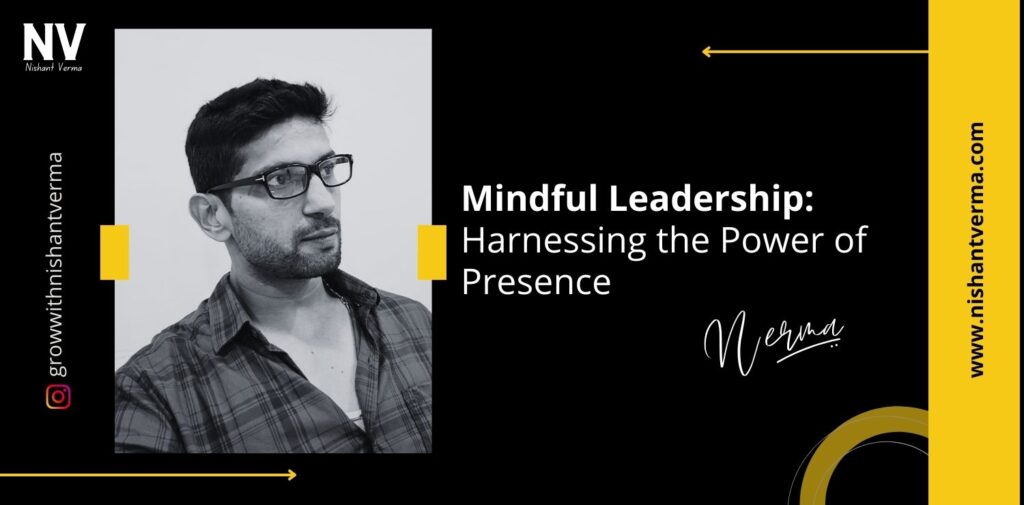In our fast-paced world, being a leader can sometimes feel like a juggling act. There are meetings to attend, decisions to make, and a constant stream of tasks demanding attention. Amidst this chaos, mindful leadership emerges as a powerful guide. Mindful leadership is about harnessing the power of presence – being fully engaged in the present moment with an open and non-judgmental awareness. In this article, we’ll explore the essence of mindful leadership in simple terms, uncovering how it can transform how we lead and inspire others.

Understanding Mindfulness: A Simple Approach
At its core, Mindfulness is about paying attention to the present moment without judgment. It involves being fully aware of our thoughts, feelings, and surroundings. Mindful leadership takes this a step further by applying these principles to leadership.
Imagine you’re having a conversation with a team member. Mindful leadership encourages you to be fully present in that conversation instead of thinking about the next meeting or worrying about an upcoming deadline. This simple shift in focus can enhance communication, foster connection, and lead to better decision-making.
The Power of Presence in Leadership
Leaders who practice mindful leadership bring a heightened sense of presence to their roles. They fully engage with their teams, actively listening and responding with intention. This level of presence fosters a positive and supportive work environment where team members feel valued and heard.
When a leader is present, they are more attuned to the moment’s needs. This allows for greater adaptability and a capacity to navigate challenges with a clear and focused mind. The power of presence lies in its ability to create a foundation for effective leadership.
Benefits of Mindful Leadership
- Improved Decision-Making: Mindful leaders make decisions with clarity and awareness. By being present in the moment, they can consider all relevant information, weigh options, and make decisions that align with the team’s or organization’s broader goals.
- Enhanced Communication: Mindful leadership transforms communication by fostering active listening and genuine connection. When leaders are fully present in conversations, they hear the words spoken and understand the emotions and concerns behind them.
- Reduced Stress: The practice of Mindfulness has been linked to stress reduction. Mindful leaders are better equipped to manage stress, which, in turn, positively influences the overall well-being of the Team.
- Increased Resilience: Mindful leaders exhibit resilience in the face of challenges. They approach setbacks with a balanced perspective, learning from experiences rather than becoming overwhelmed.
- Positive Workplace Culture: The presence of a mindful leader sets the tone for a positive workplace culture. Team members feel supported, motivated, and encouraged to bring their best selves to their work.

Practical Tips for Mindful Leadership
- Start with Self-Awareness: Mindful leadership begins with self-awareness. Take a few moments each day to reflect on your thoughts, emotions, and reactions. This self-awareness forms the foundation for mindful leadership.
- Practice Active Listening: In conversations, make a conscious effort to be fully present. Avoid distractions, maintain eye contact, and listen with the intention of understanding. This simple act can transform the quality of communication.
- Integrate Mindfulness into Daily Routines: Incorporate Mindfulness into daily routines. Whether it’s a short meditation session, a mindful walk, or a few moments of deep breathing, these practices can help anchor you in the present moment.
- Encourage Mindfulness in the Team: Share the benefits of Mindfulness with your Team and encourage them to incorporate mindful practices into their work routines. This could include brief moments of reflection before meetings or designated mindfulness breaks.
- Embrace Open-Mindedness: Mindful leaders approach situations with an open mind, free from preconceived notions or judgments. This open-mindedness promotes creativity, collaboration, and a more inclusive work environment.
Real-Life Examples of Mindful Leadership: power of presence
Let’s explore two real-life examples of mindful leadership:
- Example 1: Steve, the Team Leader : Steve leads a creative team in a fast-paced advertising agency. Recognizing the importance of Mindfulness in fostering creativity, Steve starts team meetings with a short mindfulness exercise. This could be a brief meditation or a moment of silent reflection. By creating this intentional space for power of presence, Steve sets a positive tone for the meeting, allowing team members to bring their creative ideas to the forefront.
- Example 2: Sarah, the CEO : As the CEO of a tech company, Sarah faces numerous challenges daily. Instead of succumbing to the pressure, Sarah practices Mindfulness to maintain focus and clarity. She starts her day with a mindfulness routine that includes deep breathing and visualization. This helps her approach each challenge, make informed decisions, and inspire her Team to navigate obstacles with resilience.
Challenges and Misconceptions
- Perceived Time Constraints: One common misconception about mindful leadership is the perceived time constraints. Leaders often feel that they don’t have the luxury to slow down and be present. However, the time invested in Mindfulness pays off through improved focus, productivity, and overall well-being.
- Resistance to Change: Some leaders may resist incorporating Mindfulness into their leadership style due to a fear of change or skepticism about its effectiveness. Overcoming this resistance involves understanding the tangible benefits and starting with small, manageable steps.
- Cultural Considerations: Mindfulness practices may vary across cultures. Leaders need to be sensitive to cultural considerations and adapt mindful leadership practices in a way that resonates with the diverse backgrounds of their team members.
Mindful Leadership in Challenging Times
In times of crisis or uncertainty, the principles of mindful leadership become even more critical. The ability to remain present, make informed decisions, and support the Team’s well-being Teamnvaluable during challenging periods. Mindful leaders act as stabilizing forces, guiding their teams through turbulence with grace and resilience.

Creating a Mindful Organizational Culture
Leadership extends beyond individual actions; it shapes the culture of an entire organization. To create a mindful organizational culture, leaders can:
- Promote Work-Life Balance: Encourage employees to maintain a healthy work-life balance. Recognize and appreciate their efforts while emphasizing the importance of taking breaks and recharging.
- Provide Mindfulness Resources: Offer resources such as mindfulness workshops, training sessions, or access to meditation apps. Providing these resources signals the organization’s commitment to supporting employees’ mental well-being.
- Foster Inclusivity: Mindfulness promotes inclusivity by encouraging non-judgmental awareness. Leaders can foster an inclusive culture where diverse perspectives are valued, and everyone feels heard and respected.
- Lead with Empathy: Mindful leaders lead with empathy understanding the challenges faced by their team members. Expressing empathy builds trust and strengthens the bond between leaders and their teams.
Measuring the Impact of Mindful Leadership
Measuring the impact of mindful leadership goes beyond traditional performance metrics. Consider the following indicators:
- Employee Satisfaction: Gauge employee satisfaction through surveys or feedback mechanisms. A positive shift in employee satisfaction may indicate the positive impact of mindful leadership.
- Team Collaboration: Assess the level of collaboration within teams. Increased collaboration often results from improved communication and a supportive work environment fostered by mindful leadership.
- Stress Reduction: Monitor stress levels within the organization. Reducing stress-related issues, such as burnout or absenteeism, may indicate the positive effects of mindful leadership.
- Innovation and Creativity: Track the organization’s innovation and creativity metrics. Mindful leadership has been linked to enhanced creativity, encouraging a free flow of ideas and open-minded thinking
Conclusion: Embracing Mindful Leadership for a Better Tomorrow
In the leadership journey, mindful leadership is a beacon of wisdom, reminding us to be present, compassionate, and intentional in our actions. Incorporating simple mindfulness practices into our leadership approach can create a positive ripple effect beyond the workplace.
The power of presence is not limited to the leader alone; it permeates the entire Team, Creating a culture of Mindfulness, collaboration, and well-being. As we navigate the complexities of leadership, let us harness the transformative power of presence and lead with Mindfulness for a better tomorrow – one that values success in business and the well-being and fulfillment of every individual within the organization. Mindful leadership is not just a leadership style; it’s a journey toward creating a workplace where people thrive, connect, and contribute their best selves.




